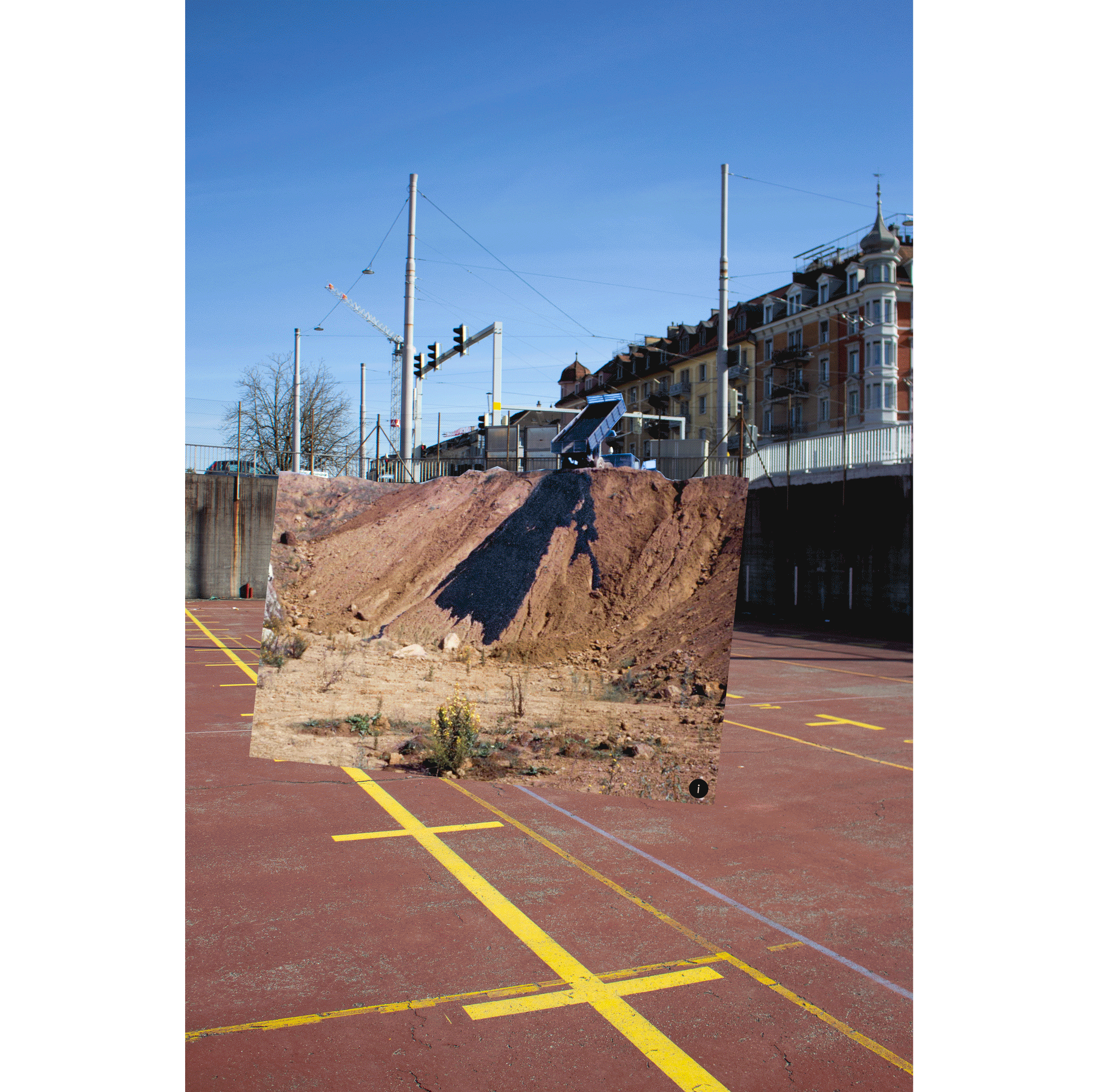“(...) unlike either the Anthropocene or the Capitalocene, the Chthulucene is made up of ongoing multispecies stories and practices of becoming-with in times that remain at stake, in precarious times in which the world is not finished and the sky has not fallen—yet. Human beings are not the only important actors in the Chthulucene, with all other beings able simply to react. The order is reknitted.”
Donna J. Haraway
Refuge for multi-species within
the urban landscape required
Let me be frank with you, it is a crisis. We keep losing a tremendous number of our companion species. Switzerland lost half of them in the last 30 years, no less. Contrary to popular misconceptions, there is more biodiversity in the city than in the countryside. Rural areas are being strongly affected by monoculture, while the urban environment offers more life-welcoming niches and a higher variety of conditions for multiple species. Yet, in Zurich, growth and densification are threatening these habitats.
It is time to deconstruct the dichotomous myth of nature and culture and start to think about “How can we live together?”
It's time for collaboration with other earthlings.
![]() infoflora.ch
infoflora.ch
It is time to deconstruct the dichotomous myth of nature and culture and start to think about “How can we live together?”
It's time for collaboration with other earthlings.
 infoflora.ch
infoflora.ch

tentacular toolbox: research drawing putting in relation fragments of knowledge where different actors meet and interact without hierarchy. Everything is connected to something, but not everything is connected to everything.* Donna J. Haraway




click and then press on your <- and -> keys to read the story
Climate change means the amplification of extreme conditions. A higher number of diverse niches means developing a resilient backup system for other species to find refuge and migrate: response-ability.

nccs.admin.ch



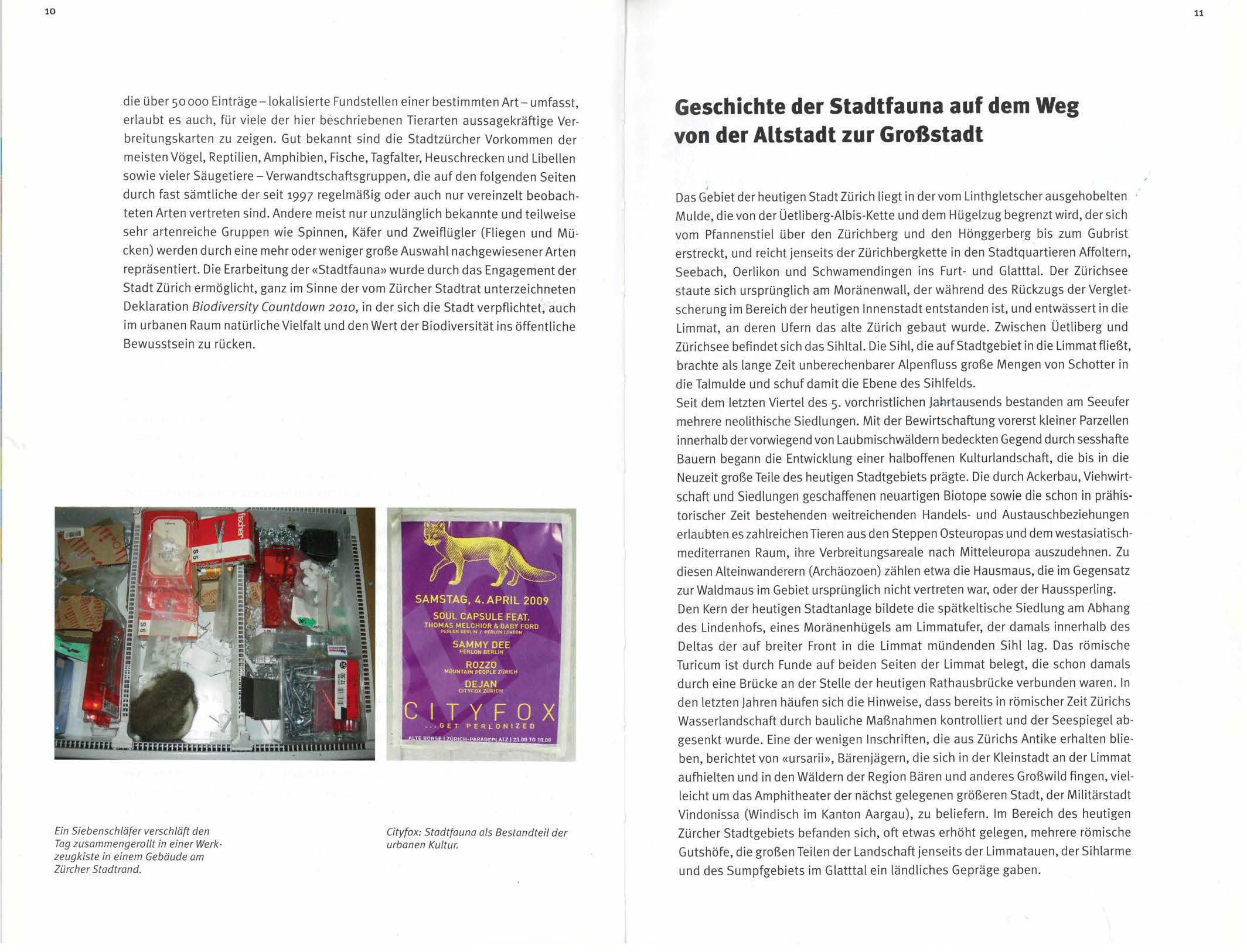
















Grün Stadt Zürich's Biotoptypenkartierung 2020 is a survey that maps and rates the city’s different biotopes through the analysis of insitu plants - a botanists' methodology. In it, we discovered an exciting pattern. A large number of relevant biotopes is linked to places of cultural relevance such as cemeteries, universities, hospitals or allotment gardens.
"Sous les pavés, la plage !"
ou la séparation moderniste
des systèmes
Thin coat of asphalt covering the ground. Diversity of soils below the sealed surface. Veins of hermetically channeled streams, somewhere in-between. Groundwater just a little lower.
The urban grounds and soils we walk over are built as an artificial division of systems, where exchanges with water and light are avoided through impermeable surfaces. The different actors are overlaid, but rarely do they have the opportunity to meet and contaminate each other.



section through the Limmatal’s soils from the surface to the bedrock
 Zurich covered by a glacier
15'000 years ago.
Zurich covered by a glacier
15'000 years ago.Zurich is a region characterized by its many streams, today often buried underground.
 Historical map of the Limmat valley by Hans Conrad Gyger (1667)
Historical map of the Limmat valley by Hans Conrad Gyger (1667)
Documentation of the drill cores of a subsoil investigation at Bienenstrasse made by the city of Zurich





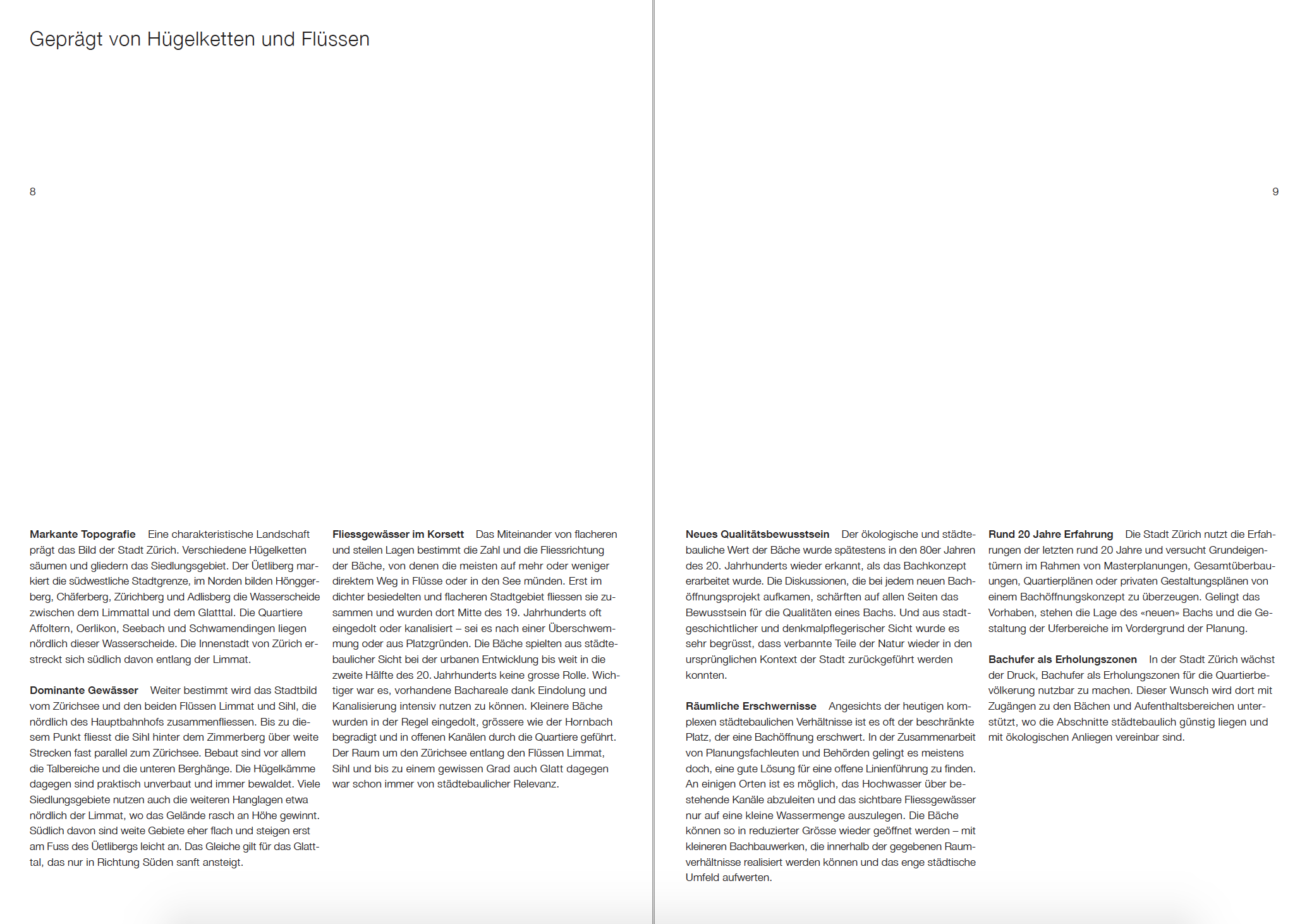
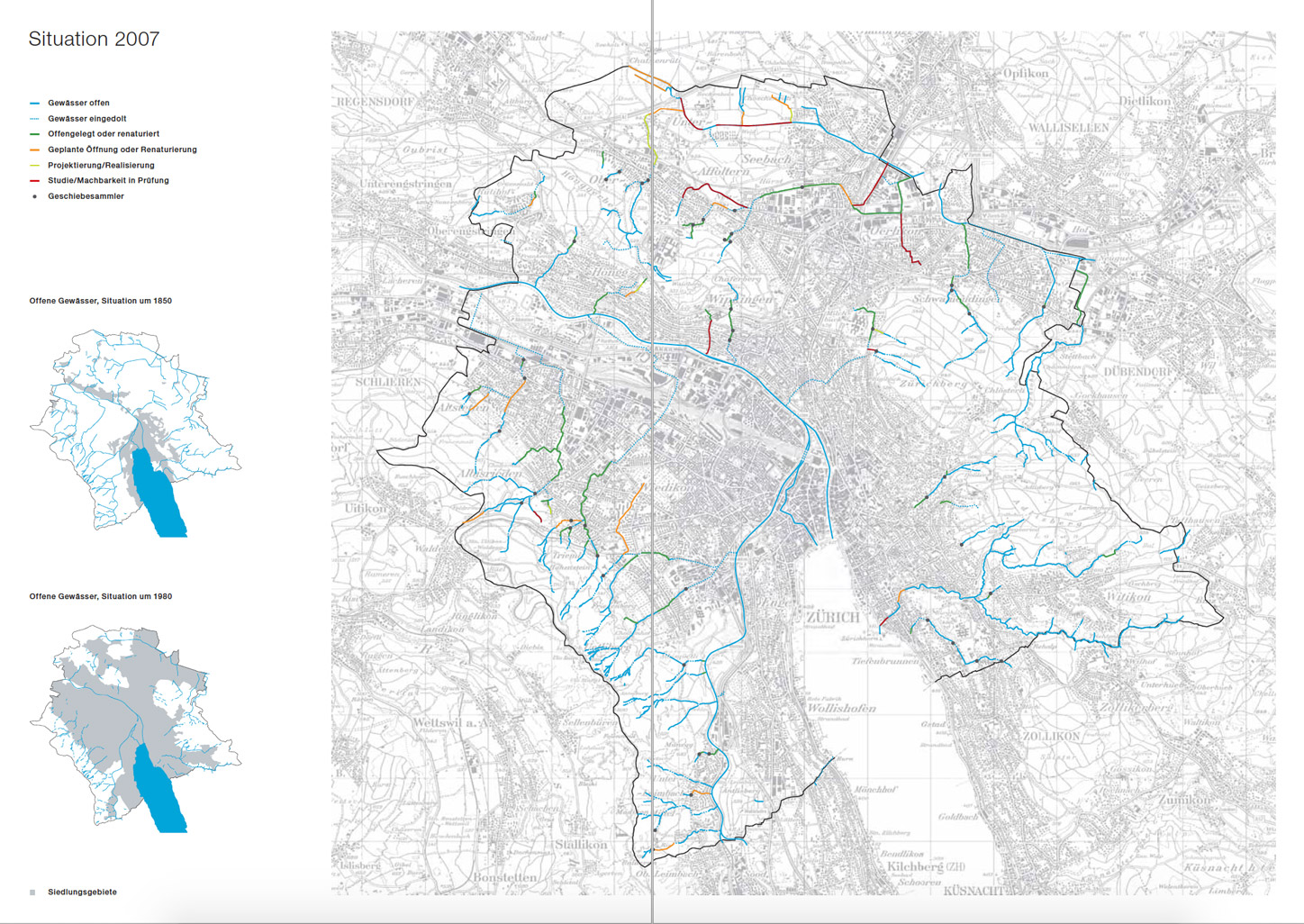
Stream concept of 2007, currently revised and updated, from the Zurich Waste Disposal and Recycling Department (ERZ) whose employees kindly answered any questions we had.
"An important factor threatening biodiversity and ecological functions in settlement areas is a high degree of sealing and underground construction. (...) Overall, a maximum degree of sealing of 20-45% and ideally, if possible, a maximum of 15% in all zones should be aimed for."
ILF & HSR’s concept study for the Federal Office for the Environment






ILF & HSR’s concept study for the Federal Office for the Environment
on the integration of biodiversity in building regulations.

Analysis of the ground along the Döltschibach, our case study, in a 250m x 250m resolution to calculate the minimum surface that should be unsealed, according to the official ILF & HSR concept study.




Break the ground,
re-establish the
symbiosis
By bringing water, soil and light together, valuables niches and biotopes could be generated.
Acting along the channeled streams of Zurich with punctual interventions, we aim to rethink the organisation and ecological value of what is to be found beneath our feet. Excavation is our main tool. We will create porous conditions, reach the stream water inhabited by micro-organisms, work with the different soils found on site and initiate a new diversity of dynamics through collaboration, architecture, form and chance. All the excavated material should be reused, nothing leaves the circuit.
To do so, we developed five typologies applicable to the whole city and choose the Döltschi-stream as our case study.
Clients

Microbial communities
The above-ground community is intimately intermingled with the belowground one and couldn’t exist without it. The invisible critters inhabiting the earth represent the most important part of biodiversity. One teaspoon of healthy soil contains billions of these living organisms. They act as a sympoietic community collaborating in a cyclic rhythm with the above-ground one. It takes time for a soil to become healthy again, more than it takes for plants to grow.
Spontaneous vegetation
We aim to create conditions and space for other species to appropriate our interventions and spread. In that sense, porosity, decay and time are major design factors. Spontaneous vegetation works as a pioneer for other species and stands for resilience, as it has the capacity to adapt and create a hospitable habitat out of hostile conditions.




Succession
Ecological succession is the process of colonization of plants through time. It starts with pioneer species, such as cryptogams - like lichens and mosses -, growing on mineral matter, and creating the conditions for larger inhabitants - such as grasses, shrubs and finally trees - to gradually take over.

The Döltschi-stream as our case study.
I. GRABEN
In order to expose the channeled stream, the bare necessary is done. A ditch will be excavated in the dimension of the asphalted path between Max Frisch Bad and Letzigrabenstrasse. Only one and a half meters deep, the spatial experience should remind of a forest stream, one is at eye level with the roots and the meadow on which the various trees grow. Their leaves fall into the trench and are being processed into humus by various species. A self-sustaining community - a contrast to the highly maintained public pool.
Where the trees grow close to the path, a slope of thirty degrees is left to give space to the roots. The other cut is retained by a lime wall. Through the alternation of the two wall constructions, the exposed stream is forced to meander. This leads to different water velocities and bank constitutions, thus to different habitats.



Döltschibach
a



ground plan 1:500


II.COUR ANGLAISE
This intervention creates a lowered courtyard along the facade of the residential buildings on Herdernstrasse. The existing basement wall becomes the back wall of the courtyard. The three newly built walls have a concrete structure and are clad with a layer of porous bonded lime. Through different sun exposure, four individual wall habitats are created.
Over bridges out of large concrete pipes, one reaches the residential buildings. As if through a showcase, one looks down into the courtyard to an almost romanticized image of nature. But of course, everything is built, the stream meanders through reused asphalt clods, and the water that runs over the porous walls is tapped from the roof water. But where does this originally foreign fig tree come from? Is it also artificially brought into play or did its seeds float down the stream -- maybe a local one after all?



a



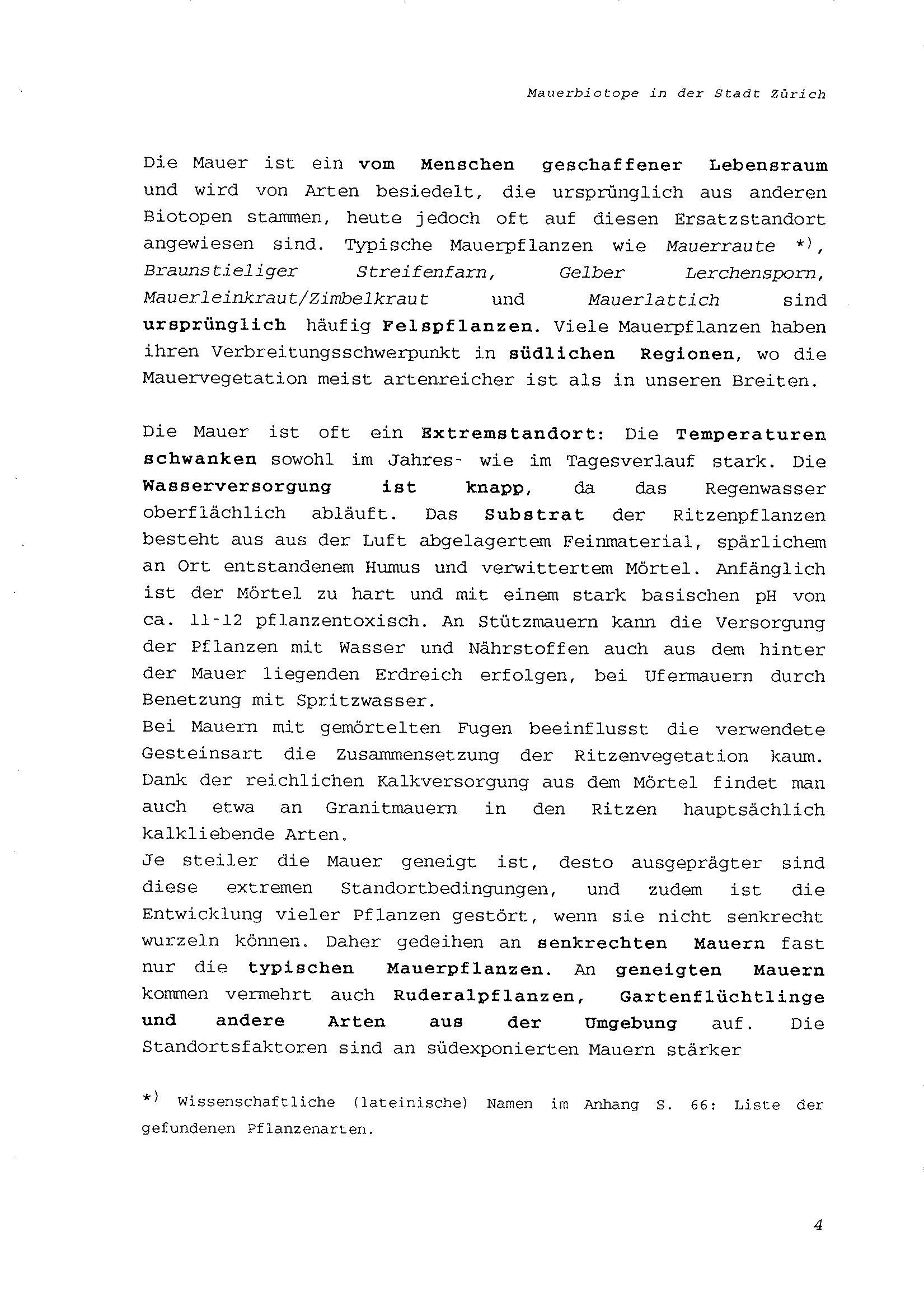



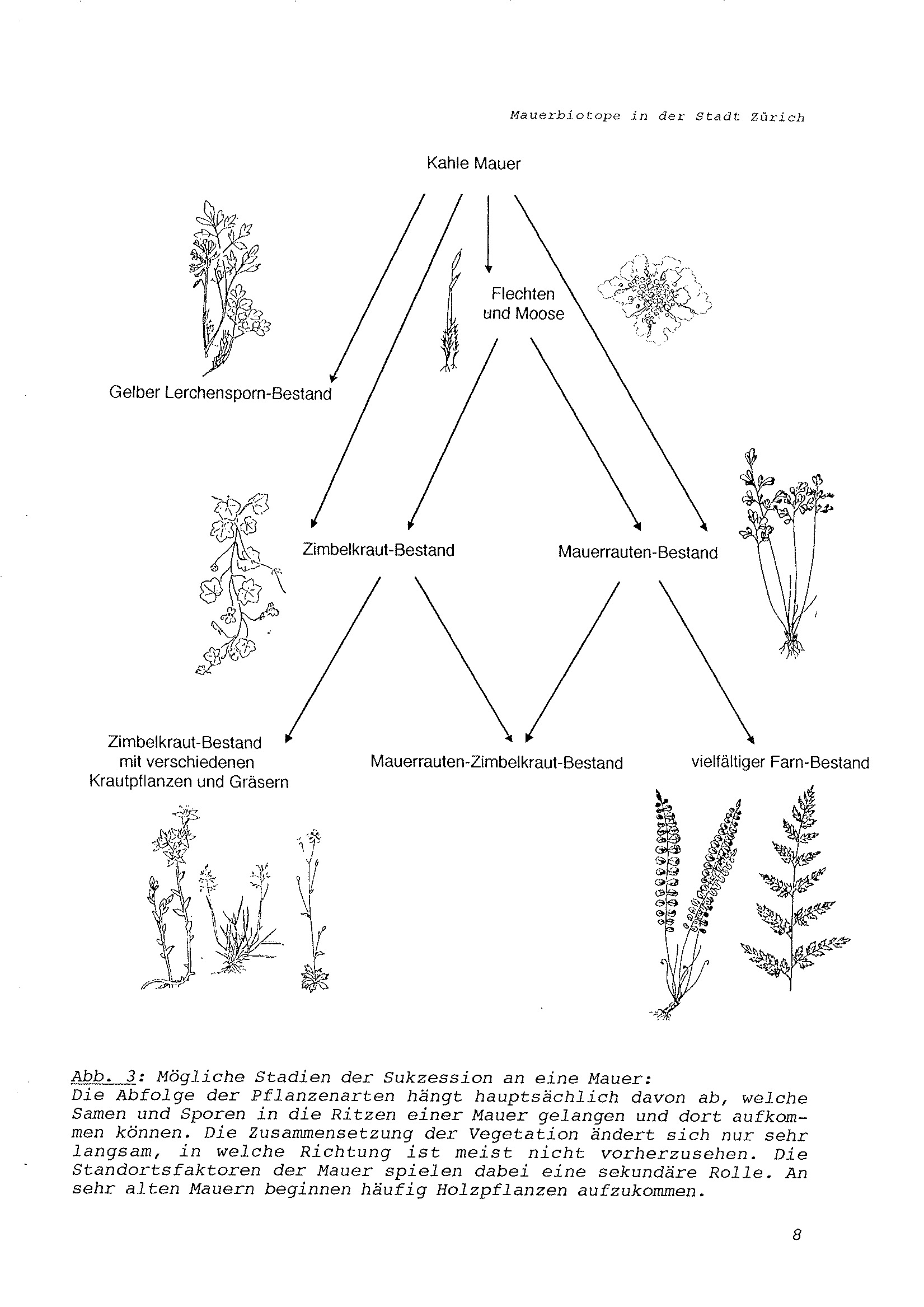









Excerpts from the inventory of walls with crevice vegetation in Zurich, 1995
"From the 2000 species mapped in Zurich, 15% are found on walls. "
excerpt, Research Book first semester

ground plan 1:300





















Excerpts from the book Ecology of Walls, which we encountered at the very beginning of our research semester and which was a valuable tool ever since.

The heterogenous excavated material of other sites is brought here. Each pile is unique, an imported piece of city with specific soil, PH, density, and porosity. The topography formed plays with the sun, creating shadow and an even greater variety of conditions. The stream slowly dances its meanders in-between and unpredictably digs its way in the loamy soil to follow the terrain’s slope — the easiest path. In times of flood, the water breaks the boundary and runs on the asphalt only to be caught by the backup drainage line. Geckos come to visit from the Gleisfeld. Humans walk down the street-connecting big pile.



a


Mississippi River Meander Belt,
1944 Harold Fisk

early concept sketch

ground plan 1:200 with the simulation of the stream’s meander evolving through time

Eduard Neuenschwander in Niemandsland, 1988


IV. THE HOLE
The hole is located in a large parking lot, between railroad bridges, tracks and roads. In this area, the degree of sealed surface is one of the highest in Zurich. The asphalt will be broken up in a circle 60 meters in diameter and the stream pipe will be exposed in the form of a crater. It is dug even deeper than the pipe as to poke through the hole like an aqueduct. To fully expose the stream, the pipe is cut into a half-pipe, which overflows when large amounts of water are present and moistens the deeper part of the crater.



a



The Monuments of Passaic, Robert Smithson, 1967
 section 1:100
section 1:100

“Not scale, size. Size is real, scale is imagined size. Scale could be said to be an aesthetic measurement whereas size is an actual measurement."
Michael Heizer in Sculpture in Reverse with Julia Brown, 1984

V. INFRASTRUCTURAL PARK
Here, everything is organized in separated lines. The modernist spirit inhabiting the urban design of the Pfingsweidstrasse feels somewhat sterile. The facades of the buildings have little relief, and the 14 meters pavement facing the Börse is sealed with asphalt for no apparent reason. Everything is clean, perhaps too clean? In summer, this absorbing black surface makes the street hot, extremely hot.
So here is our two for one offer: We break —but keep— the asphalt. We work with the existing linear system to complete and add stripes of different habitats, from wet (stream) to dry (porous asphalt), that we then connect through slope and pipes. The pipes regulate the floods of heavy rain and act as an underpass for other species. As for the plants newly occupying the place, they help regulating the extreme conditions of heat and flood. It’s a win-win situation.



a




ground plan 1:500


THE BIG ENOUGH STORY
During the industrial era, the streams of Zurich were misused for the discharge of polluted wastewater from settlements and industry, reduced to infrastructure with consequences being increasingly visible and nauseating. In the twenties—the so-called modern times, most of these streams were channeled, shaping the city as we know it today. This planning stance reflected a posture in which systems had to be segregated and space made available for urbanization, leading to entire chunks of urban fabric covering the streams. From the nineties onward, a paradigmic change emerged. The planning authorities of Zurich are now willing to reopen some of the streams for ecological, economic, or social reasons. The question remains how?
The five typologies we developed in this work are meant to be spread across Zurich, punctually connected to its large network of channeled watercourses.
By breaking the ground open, the streams will be visible and their presence celebrated. To do so, the work seeks for collaboration with other actors, abiotic and living, without hierarchy, where space is offered for other stories to occur.
From the lichen to the city, we aim for the big enough story that can assemble complexities and keep edges open, greedy for surprising new and old connections*.
*Donna J. Haraway


